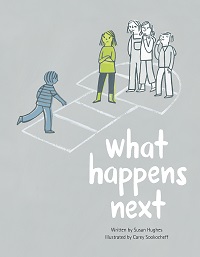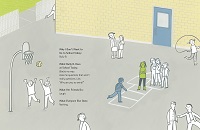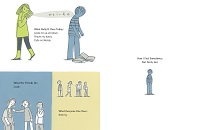| ________________
CM . . . . Volume XXIV Number 34. . . . May 4, 2018
excerpt:
What Happens Next is the latest picture book adding to a growing roster of children’s literature about bullying. The growth of this subject area is heartening since children and youth identify bullying as their most pressing social concern. Written by Susan Hughes and illustrated by Carey Sookocheff, this Spartan new work is best suited for use by adults with readers aged seven through twelve.
Although the intentions of What Happens Next are noble, and its “positive” narrative resolution inspiring, there are many problematic elements at play. Because this text is an “issue” book rather than a story intended primarily for entertainment, it carries the burden of responsibility to represent its topic with accuracy rather than being free simply to provide inspiration or enjoyment (this is further emphasized by the prolonged focus on scientific facts when the narrator describes genomes and the role of water). Therefore, What Happens Next will almost certainly be co-opted into bibliotherapeutic and/or socializing endeavours rather than enjoyed for fun. Many psychologists and educators have developed extensive parameters for the effective use of bibliotherapy; these experts consider accurate representation of the issue along with the promotion of effective strategies mandatory. What Happens Next is not an effective resource for two reasons. First, the narrative conflict is resolved with a strategy that is completely adult generated and enforced, leaving no room for the child protagonist’s ideas or efforts. While adult advocates certainly play a crucial role in supporting children to reduce bullying, in reality, they must work with children—and the realities of childhood social structures—to develop effective, respectful strategies. In didactic literature, this reality should be mirrored. Second, the solution to the conflict does not accurately reflect research findings beginning to be revealed after decades of dedicated anti-bullying efforts: “befriending the bully” is unlikely to work. Further, when enacted by a single child, it is likely to place the child at risk. It is not an appropriate strategy to promote through the representation of a positive narrative resolution. If the story were more imaginative, and/or intended to be read for fun, then this would not be so problematic. What Happens Next is not an effective resource for two reasons. First, the narrative conflict is resolved with a strategy that is completely adult generated and enforced, leaving no room for the child protagonist’s ideas or efforts. While adult advocates certainly play a crucial role in supporting children to reduce bullying, in reality, they must work with children—and the realities of childhood social structures—to develop effective, respectful strategies. In didactic literature, this reality should be mirrored. Second, the solution to the conflict does not accurately reflect research findings beginning to be revealed after decades of dedicated anti-bullying efforts: “befriending the bully” is unlikely to work. Further, when enacted by a single child, it is likely to place the child at risk. It is not an appropriate strategy to promote through the representation of a positive narrative resolution. If the story were more imaginative, and/or intended to be read for fun, then this would not be so problematic. If What Happens Next were used in an anti-bullying unit with many other works of children’s literature portraying various bullying situations, and if an adult advocate was able to develop activities promoting critical thinking about the story—especially the narrative resolution—then it may find its place. Otherwise, teachers and librarians with limited budgets should invest in more empowering resources. Recommended with Reservations. Michelle Superle is an Assistant Professor at the University of the Fraser Valley where she teaches children’s literature and creative writing courses. She has served twice as a judge for the TD Canadian Children’s Literature Award and is the author of Black Dog, Dream Dog and Contemporary, English-language Indian Children’s Literature (Routledge, 2011). She has developed the “Read for Your Rights!” literary mentorship program to support children in helping each other use their rights to reduce bullying at school.
Next Review |
Table of Contents for This Issue
- May 4, 2018. |

 Narrated by an unnamed young protagonist in an unusual style more reminiscent of text messaging than picture books, What Happens Next focuses on a bullied child’s experiences at school. The speaker describes being shunned and called “Weirdo” by “Bully B.” At home, the child is consumed by negative feelings until Mom suggests a walk outside. That night, the child is finally able to describe the bully’s behavior, telling Mom “everything”. In response, she steps in to save the day by explaining why people bully and how to stop them. She offers two possible solutions: she will talk to the principal, or the child can try to “help” Bully B. This “help” is comprised of telling the bully “some of the things I love to think about” because it “might help Bully B. change her way of thinking.” The next day, with Mom looking on from the schoolyard gate, the child plays out this strategy. After the narrator espouses pages of scientific explanations describing how genomes work and how much of life is enabled by the presence of water, Bully B. is finally moved to respond, “W—ow.” She subsequently stops calling the protagonist Weirdo. The child is satisfied because, although “not everything” is “different now”, just “enough” is.
Narrated by an unnamed young protagonist in an unusual style more reminiscent of text messaging than picture books, What Happens Next focuses on a bullied child’s experiences at school. The speaker describes being shunned and called “Weirdo” by “Bully B.” At home, the child is consumed by negative feelings until Mom suggests a walk outside. That night, the child is finally able to describe the bully’s behavior, telling Mom “everything”. In response, she steps in to save the day by explaining why people bully and how to stop them. She offers two possible solutions: she will talk to the principal, or the child can try to “help” Bully B. This “help” is comprised of telling the bully “some of the things I love to think about” because it “might help Bully B. change her way of thinking.” The next day, with Mom looking on from the schoolyard gate, the child plays out this strategy. After the narrator espouses pages of scientific explanations describing how genomes work and how much of life is enabled by the presence of water, Bully B. is finally moved to respond, “W—ow.” She subsequently stops calling the protagonist Weirdo. The child is satisfied because, although “not everything” is “different now”, just “enough” is.  Carey Sookocheff’s spare, cartoon-like line drawings coloured minimally with a muted palette illustrate middle-grade aged children, revealing that, although this story is packaged as a picture book and thus could be reasonably used with Kindergarten children, it may be better suited to the older child readers who experience bullying most often and most severely—middle schoolers. These illustrations seem to suggest that the child narrator is a boy, which creates a refreshingly underrepresented bullying scenario.
Carey Sookocheff’s spare, cartoon-like line drawings coloured minimally with a muted palette illustrate middle-grade aged children, revealing that, although this story is packaged as a picture book and thus could be reasonably used with Kindergarten children, it may be better suited to the older child readers who experience bullying most often and most severely—middle schoolers. These illustrations seem to suggest that the child narrator is a boy, which creates a refreshingly underrepresented bullying scenario.